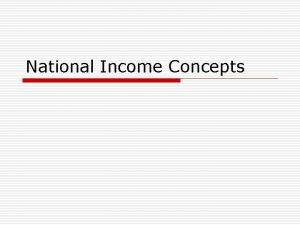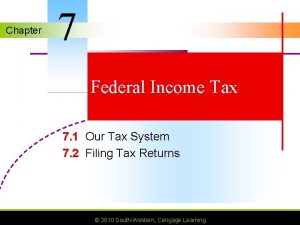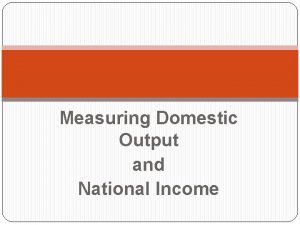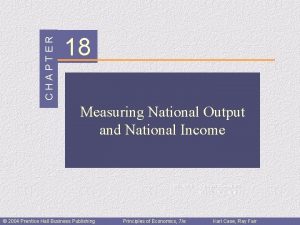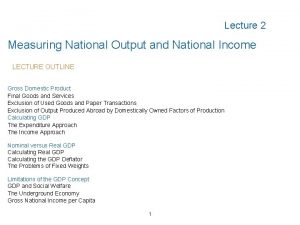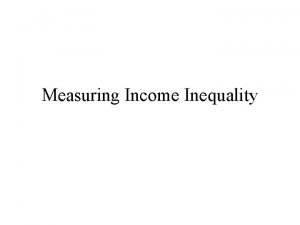CHAPTER 18 Measuring National Output and National Income












































- Slides: 44

CHAPTER 18 Measuring National Output and National Income Prepared by: Fernando Quijano and Yvonn Quijano © 2004 Prentice Hall Business Publishing Principles of Economics, 7/e Karl Case, Ray Fair

C H A P T E R 18: Measuring National Output and National Income and Product Accounts • National income and product accounts NIPA are data collected and published by the government describing the various components of national income and output in the economy. • In Palestine NIPA are collected and summarized by the Palestinian Central Bureau of Statistics (PCBS). © 2004 Prentice Hall Business Publishing Principles of Economics, 7/e Karl Case, Ray Fair 2 of 38

C H A P T E R 18: Measuring National Output and National Income • What Is GDP? • 1. Gross Domestic Product (GDP) is the most basic measure of how an economy is performing. • 2. Gross Domestic Product is the total market value of a country’s output. It is the market value of all final goods and services produced in a country during a calendar year by factors of production located within that country. © 2004 Prentice Hall Business Publishing Principles of Economics, 7/e Karl Case, Ray Fair 3 of 38

C H A P T E R 18: Measuring National Output and National Income Final Goods and Services • The term final goods and services in GDP refers to goods and services produced for final use. • Intermediate goods are goods produced by one firm for use in further processing by another firm. © 2004 Prentice Hall Business Publishing Principles of Economics, 7/e Karl Case, Ray Fair 4 of 38

C H A P T E R 18: Measuring National Output and National Income Value Added In calculating GDP, we can either sum up the value added at each stage of production, or we can take the value of final sales Value Added in the Production of a Gallon of Gasoline (Hypothetical Numbers) STAGE OF PRODUCTION VALUE OF SALES VALUE ADDED $. 50 (2) Refining . 65 . 15 (3) Shipping . 80 . 15 1. 00 . 20 (1) Oil drilling (4) Retail sale Total value added © 2004 Prentice Hall Business Publishing $1. 00 Principles of Economics, 7/e Karl Case, Ray Fair 5 of 38

C H A P T E R 18: Measuring National Output and National Income Value Added • Value added is the difference between the value of goods as they leave a stage of production and the cost of the goods as they entered that stage. • Value added is the difference between a firm’s total revenue and what it pays other firms for intermediate goods. Value added includes wages and salaries, rent, interest, and profits. © 2004 Prentice Hall Business Publishing Principles of Economics, 7/e Karl Case, Ray Fair 6 of 38

C H A P T E R 18: Measuring National Output and National Income Exclusions of Used Goods and Paper Transactions • Exclusion of Used Goods and Paper Transactions: NIPA exclude purchases and sales of previously owned goods and paper asset transactions because GDP includes only newly produced goods and services. • 1. Previously owned goods were counted when they were first produced. • 2. Paper asset transactions (bonds and stocks) are not counted because they are not new goods or services. © 2004 Prentice Hall Business Publishing Principles of Economics, 7/e Karl Case, Ray Fair 7 of 38

C H A P T E R 18: Measuring National Output and National Income Exclusion of Output Produced Abroad by Domestically Owned Factors of Production • GDP is the value of output produced by factors of production located within a country. • Gross National Product (GNP): Output produced by a country’s citizens, regardless of where the output is produced, © 2004 Prentice Hall Business Publishing Principles of Economics, 7/e Karl Case, Ray Fair 8 of 38

C H A P T E R 18: Measuring National Output and National Income Calculating GDP can be computed in two ways: • The expenditure approach: A method of computing GDP that measures the total amount spent on all final goods during a given period. • The income approach: A method of computing GDP that measures the income—wages, rents, interest, and profits—received by all factors of production in producing final goods. © 2004 Prentice Hall Business Publishing Principles of Economics, 7/e Karl Case, Ray Fair 9 of 38

C H A P T E R 18: Measuring National Output and National Income The Expenditure Approach • The expenditure approach calculates GDP by adding together the four components of spending. In equation form: © 2004 Prentice Hall Business Publishing Principles of Economics, 7/e Karl Case, Ray Fair 10 of 38

C H A P T E R 18: Measuring National Output and National Income The Expenditure Approach Expenditure categories: • Personal consumption expenditures (C)— household spending on consumer goods. • Gross private domestic investment (I)— spending by firms and households on new capital: plant, equipment, inventory, and new residential structures. © 2004 Prentice Hall Business Publishing Principles of Economics, 7/e Karl Case, Ray Fair 11 of 38

C H A P T E R 18: Measuring National Output and National Income The Expenditure Approach Expenditure categories: • Government consumption and gross investment (G) • Net exports (EX – IM)—net spending by the rest of the world, or exports (EX) minus imports (IM) © 2004 Prentice Hall Business Publishing Principles of Economics, 7/e Karl Case, Ray Fair 12 of 38

C H A P T E R 18: Measuring National Output and National Income Components of GDP, 1999: The Expenditure Approach Components of GDP, 2002: The Expenditure Approach Personal consumption expenditures (C) Durable goods Nondurable goods Services Gross private domestic investment (l) Nonresidential Residential Change in business inventories Government consumption and gross investment (G) Federal State and local Net exports (EX – IM) Exports (EX) Imports (IM) Total gross domestic product (GDP) BILLIONS OF DOLLARS PERCENTAGE OF GDP 7303. 7 871. 9 2115. 0 4316. 8 1543. 2 1117. 4 471. 9 3. 9 1972. 9 693. 7 1279. 2 - 423. 6 1014. 9 1438. 5 10446. 2 69. 9 8. 3 20. 2 41. 3 14. 8 10. 7 4. 5 0 18. 9 6. 6 12. 2 - 4. 1 9. 8 13. 8 100. 0 Note: Numbers may not add exactly because of rounding. Source: U. S. Department of Commerce, Bureau of Economic Analysis. © 2004 Prentice Hall Business Publishing Principles of Economics, 7/e Karl Case, Ray Fair 13 of 38

C H A P T E R 18: Measuring National Output and National Income Personal Consumption Expenditures • Personal consumption expenditures (C) are expenditures by consumers on the following: • Durable goods: Goods that last a relatively long time, such as cars and appliances. • Nondurable goods: Goods that are used up fairly quickly, such as food and clothing. • Services: Things that do not involve the production of physical things, such as legal services, medical services, and education. © 2004 Prentice Hall Business Publishing Principles of Economics, 7/e Karl Case, Ray Fair 14 of 38

C H A P T E R 18: Measuring National Output and National Income Gross Private Domestic Investment • Investment refers to the purchase of new capital. • Total investment by the private sector is called gross private domestic investment. It includes the purchase of new housing, plants, equipment, and inventory by the private sector. © 2004 Prentice Hall Business Publishing Principles of Economics, 7/e Karl Case, Ray Fair 15 of 38

C H A P T E R 18: Measuring National Output and National Income Gross Private Domestic Investment • Nonresidential investment includes expenditures by firms for machines, tools, plants, and so on. • Residential investment includes expenditures by households and firms on new houses and apartment buildings. • Change in inventories computes the amount by which firms’ inventories change during a given period. • Inventories includes: raw material, intermediate goods, spareparts for machines, and over-production of final goods. • Inventories are the goods that firms produce now but intend to sell later. © 2004 Prentice Hall Business Publishing Principles of Economics, 7/e Karl Case, Ray Fair 16 of 38

C H A P T E R 18: Measuring National Output and National Income Gross Private Domestic Investment • Remember that GDP is not the market value of total sales during a period—it is the market value of total production. • The relationship between total production and total sales is: GDP = final sales + change in business inventories Change in business inventories = GDP - final sales © 2004 Prentice Hall Business Publishing Principles of Economics, 7/e Karl Case, Ray Fair 17 of 38

C H A P T E R 18: Measuring National Output and National Income Gross Investment versus Net Investment • Gross investment is the total value of all newly produced capital goods (plant, equipment, housing, and inventory) produced in a given period. • Depreciation is the amount by which an asset’s value falls in a given period. • Net investment equals gross investment minus depreciation. © 2004 Prentice Hall Business Publishing Principles of Economics, 7/e Karl Case, Ray Fair 18 of 38

C H A P T E R 18: Measuring National Output and National Income Government Consumption and Gross Investment • Government consumption and gross investment (G) counts expenditures by federal, state, and local governments for final goods and services. © 2004 Prentice Hall Business Publishing Principles of Economics, 7/e Karl Case, Ray Fair 19 of 38

C H A P T E R 18: Measuring National Output and National Income Net Exports • Net exports (EX – IM) is the difference between exports and imports. The figure can be positive or negative. • Exports (EX) are sales to foreigners of U. S. - produced goods and services. • Imports (IM) are U. S. purchases of goods and services from abroad). © 2004 Prentice Hall Business Publishing Principles of Economics, 7/e Karl Case, Ray Fair 20 of 38

C H A P T E R 18: Measuring National Output and National Income The Income Approach • National income is the total income earned by the factors of production owned by a country’s citizens. National Income = Compensation of employees such as wages and salaries + Proprietors’ income + Net interests + corporate profits + rental income © 2004 Prentice Hall Business Publishing Principles of Economics, 7/e Karl Case, Ray Fair 21 of 38

C H A P T E R 18: Measuring National Output and National Income The Income Approach GDP = national income + depreciation + (indirect taxes – subsidies) + net factor payments to the rest of the world + other So National Income = GDP - depreciation - (indirect taxes – subsidies) - net factor payments to the rest of the world - other © 2004 Prentice Hall Business Publishing Principles of Economics, 7/e Karl Case, Ray Fair 22 of 38

C H A P T E R 18: Measuring National Output and National Income The Income Approach Components of GDP, 2002: The Income Approach BILLIONS OF DOLLARS PERCENTAGE OF GDP 8, 199. 9 80. 3 6, 010. 0 58. 9 Proprietors’ income 943. 5 7. 3 Corporate profits 748. 9 7. 3 Net interest 554. 8 5. 4 Rental income 142. 7 1. 4 National income Compensation of employees Depreciation Indirect taxes minus subsidies Net factor payments to the rest of the world Other Gross domestic product 1, 351. 3 739. 4 11. 1 - 96. 1 10, 205. 6 13. 2 7. 2 0. 1 - 0. 9 100. 0 Source: See Table 18. 2. © 2004 Prentice Hall Business Publishing Principles of Economics, 7/e Karl Case, Ray Fair 23 of 38

C H A P T E R 18: Measuring National Output and National Income The Income Approach GNP = GDP + Payments transferred inside – Payments transferred outside GNP = GDP + receipts of factor income from the rest of the world - payments of factor income to the rest of the world NNP = GNP - depreciation NI = NNP – Indirect Taxes + Subsidies © 2004 Prentice Hall Business Publishing Principles of Economics, 7/e Karl Case, Ray Fair 24 of 38

C H A P T E R 18: Measuring National Output and National Income The Income Approach PI = NI ـــ Social Security taxes ـــ corporate profits taxes ـــ undistributed corporate profits ـــ Pension premiums installments + Social Security payments to the households + Unemployment compensation payments + Welfare payments + interest on public bond +personal interest income received from the government and consumers + dividends © 2004 Prentice Hall Business Publishing Principles of Economics, 7/e Karl Case, Ray Fair 25 of 38

C H A P T E R 18: Measuring National Output and National Income The Income Approach DPI (Disposable personal income) = PI – Personal tax © 2004 Prentice Hall Business Publishing Principles of Economics, 7/e Karl Case, Ray Fair 26 of 38

C H A P T E R 18: Measuring National Output and National Income From GDP to Disposable Personal Income GDP, GNP, National Income, Personal Income, and Disposable Personal Income, 2002 GDP Plus: receipts of factor income from the rest of the world Less: payments of factor income to the rest of the world Equals: GNP Less: depreciation Equals: net national product (NNP) Less: indirect taxes minus subsidies plus other Equals: national income Less: Plus: corporate profits minus dividends social insurance payments personal interest income received from the government and consumers transfer payments to persons Equals: personal income Less: personal taxes Equals: disposable personal income DOLLARS (BILLIONS) 10, 205. 6 + 342. 1 - 353. 2 10, 194. 5 - 1, 351. 3 8, 843. 2 - 643. 3 8, 199. 9 - 332. 6 - 731. 2 + 439. 1 +1, 148. 7 8, 723. 9 - 1, 306. 2 7, 417. 7 Source: See Table 18. 2. © 2004 Prentice Hall Business Publishing Principles of Economics, 7/e Karl Case, Ray Fair 27 of 38

C H A P T E R 18: Measuring National Output and National Income From GDP to Disposable Personal Income • Net national product equals gross national product minus depreciation; a nation’s total product minus what is required to maintain the value of its capital stock. • Personal income is the income received by households after paying social insurance taxes but before paying personal income taxes. © 2004 Prentice Hall Business Publishing Principles of Economics, 7/e Karl Case, Ray Fair 28 of 38

C H A P T E R 18: Measuring National Output and National Income Disposable Personal Income and Personal Saving, 2002 DOLLARS (BILLIONS) Disposable personal income Less: Personal consumption expenditures Interest paid by consumers to business Personal transfer payments to foreigners Equals: personal saving Personal savings as a percentage of disposable personal income: 7, 417. 7 - 7063. 5 - 204. 3 - 31. 3 118. 6 1. 6% Source: See Table 18. 2. DPI = C + S © 2004 Prentice Hall Business Publishing S = DPI - C Principles of Economics, 7/e Karl Case, Ray Fair 29 of 38

C H A P T E R 18: Measuring National Output and National Income Disposable Personal Income and Personal Saving • The personal saving rate is the percentage of disposable personal income that is saved. • If the personal saving rate is low, households are spending a large amount relative to their incomes; if it is high, households are spending cautiously. © 2004 Prentice Hall Business Publishing Principles of Economics, 7/e Karl Case, Ray Fair 30 of 38

C H A P T E R 18: Measuring National Output and National Income Nominal Versus Real GDP • Nominal GDP is GDP measured in current dollars, or the current prices we pay for things. Nominal GDP includes all the components of GDP valued at their current prices. • When a variable is measured in current dollars, it is described in nominal terms. © 2004 Prentice Hall Business Publishing Principles of Economics, 7/e Karl Case, Ray Fair 31 of 38

C H A P T E R 18: Measuring National Output and National Income Calculating Real GDP • A weight is the importance attached to an item within a group of items. • A base year is the year chosen for the weights in a fixed-weight procedure. • A fixed-weight procedure uses weights from a given base year. © 2004 Prentice Hall Business Publishing Principles of Economics, 7/e Karl Case, Ray Fair 32 of 38

C H A P T E R 18: Measuring National Output and National Income Calculating Nominal GDP To understand the different between the nominal GDP and real GDP let’s suppose that we have 1 good produced in the economy (PIZZA). PIZZA Nominal GDP Goods Prices of Pizza Quantities of Pizza Pxq Year 1 5 100 500 Year 2 7 100 700 © 2004 Prentice Hall Business Publishing Principles of Economics, 7/e Karl Case, Ray Fair 33 of 38

C H A P T E R 18: Measuring National Output and National Income Calculating Real GDP (PIZZA). PIZZA Goods Real GDP Prices of Pizza Quantities of Pizza Pxq Real GDP Year 1 5 100 500 Real GDP Year 2 5 100 500 ØReal GDP calculated the GDP of PIZZA by the fixed prices. ØIn this case there is no change in the real production © 2004 Prentice Hall Business Publishing Principles of Economics, 7/e Karl Case, Ray Fair 34 of 38

C H A P T E R 18: Measuring National Output and National Income Calculating Real GDP A Three-Good Economy (1) (2) PRODUCTION YEAR 1 YEAR 2 Q 1 Q 2 (3) (4) PRICE PER UNIT YEAR 1 YEAR 2 P 1 P 2 (5) (6) (7) (8) GDP IN YEAR 1 PRICES P 1 x Q 1 GDP IN YEAR 2 IN YEAR 1 PRICES P 1 x Q 2 GDP IN YEAR 1 IN YEAR 2 PRICES P 2 x Q 1 GDP IN YEAR 2 PRICES P 2 X Q 2 Good A 6 11 $. 50 $. 40 $3. 00 $5. 50 $2. 40 $4. 40 Good B 7 4 . 30 1. 00 2. 10 1. 20 7. 00 4. 00 Good C 10 12 . 70 . 90 7. 00 8. 40 9. 00 10. 80 $12. 10 $15. 10 $18. 40 $19. 20 Total © 2004 Prentice Hall Business Publishing Nominal GDP in year 1 Principles of Economics, 7/e Nominal GDP in year 2 Karl Case, Ray Fair 35 of 38

C H A P T E R 18: Measuring National Output and National Income Calculating Nominal and Real GDP Description Equation Resu lt Nominal GDP in the year 1 Sum ( P 1 x Q 1 ) 12. 1 Nominal GDP in the year 2 Sum ( P 2 x Q 2 ) 19. 2 If year 1 is the base year, the real GDP in the year 1 Sum ( P 1 x Q 1 ) 12. 1 If year 1 is the base year, the real GDP in the year 2 Sum ( P 1 x Q 2 ) 15. 1 If year 2 is the base year, the real GDP in the year 1 Sum ( P 2 x Q 1 ) 18. 4 If year 2 is the base year, the real GDP in the year 2 Sum ( P 2 x Q 2 ) 19. 2 © 2004 Prentice Hall Business Publishing Principles of Economics, 7/e Karl Case, Ray Fair 36 of 38

C H A P T E R 18: Measuring National Output and National Income Calculating the GDP Deflator • The GDP deflator is used in economics to account for inflation GDP deflator is the ratio of nominal GDP to real GDP multiplied by 100 © 2004 Prentice Hall Business Publishing Principles of Economics, 7/e Karl Case, Ray Fair 37 of 38

C H A P T E R 18: Measuring National Output and National Income Calculating GDP Deflator and Inflation If year 1 is the base year, the value of GDP deflator in year 2 ( Nominal GDP in Y 2 / Real GDP P 1. q 2) x 100 ( P 2. q 2 / P 1. q 2) x 100 = ( 19. 2 / 15. 1 ) x 100 = 127. 1 In this case the Inflation rate = 127. 1 ـــ 100 = 27. 1% If year 2 is the base year, the value of GDP deflator in year 1 ( Nominal GDP in Y 1 / Real GDP P 2. q 1 ) x 100 ( P 1. q 1 / P 2. q 1 ) x 100 ( 12. 1 / 18. 4 ) x 100 = 65. 7 In this case the Inflation rate = 65. 7 ـــ 100 = -34. 3 % © 2004 Prentice Hall Business Publishing Principles of Economics, 7/e Karl Case, Ray Fair 38 of 38

C H A P T E R 18: Measuring National Output and National Income Calculating GDP Deflator and Inflation If year 1 is the base year, the value of GDP deflator in year 1 ( Nominal GDP in Y 1 / Real GDP P 1. q 1) x 100 ( P 1. q 1 / P 1. q 1 ) x 100 ( 12. 1 / 12. 1 ) x 100 = 100 In this case the Inflation rate = 100 ـــ 100 = 0 If year 2 is the base year, the value of GDP deflator in year 2 ( Nominal GDP in Y 2 / Real GDP P 2. q 2) x 100 ( P 2. q 2 / P 2. q 2 ) x 100 ( 19. 2 / 19. 2 ) x 100 = 100 In this case the Inflation rate = 100 ـــ 100 = 0 © 2004 Prentice Hall Business Publishing Principles of Economics, 7/e Karl Case, Ray Fair 39 of 38

C H A P T E R 18: Measuring National Output and National Income Real and Nominal GDP • Real GDP is calculated by tracking the volume or quantity of production after removing the rate of inflation. • Nominal GDP is calculated using changing prices, while Real GDP represent the change in the volume of total output after price changes are removed. • In general the nominal GDP is bigger than real GDP because the prices increase © 2004 Prentice Hall Business Publishing Principles of Economics, 7/e Karl Case, Ray Fair 40 of 38

C H A P T E R 18: Measuring National Output and National Income GDP and Social Welfare • Society is better off when crime decreases, however, a decrease in crime is not reflected in GDP. • An increase in leisure is an increase in social welfare, but not counted in GDP. • Nonmarket and household activities are not counted in GDP even though they amount to real production. © 2004 Prentice Hall Business Publishing Principles of Economics, 7/e Karl Case, Ray Fair 41 of 38

C H A P T E R 18: Measuring National Output and National Income GDP and Social Welfare • GDP has nothing to say about the distribution of output. Redistributive income policies have no direct impact on GDP. © 2004 Prentice Hall Business Publishing Principles of Economics, 7/e Karl Case, Ray Fair 42 of 38

C H A P T E R 18: Measuring National Output and National Income The Underground Economy • The underground economy is the part of an economy in which transactions take place and in which income is generated that is unreported and therefore not counted in GDP. • Tax evasion is usually thought to be the major incentive for people to participate in the underground economy © 2004 Prentice Hall Business Publishing Principles of Economics, 7/e Karl Case, Ray Fair 43 of 38

C H A P T E R 18: Measuring National Output and National Income Gross National Income per Capita • To make comparisons of GNP between countries, currency exchange rates must be taken into account. • Gross National Income (GNI) is a measure used to make international comparisons of output. GNI is GNP converted into dollars using an average of currency exchange rates over several years adjusted for rates of inflation. • GNI divided by population equals gross national income per capita. © 2004 Prentice Hall Business Publishing Principles of Economics, 7/e Karl Case, Ray Fair 44 of 38
 Measuring domestic output and national income
Measuring domestic output and national income Outputs
Outputs Measuring domestic output and national income
Measuring domestic output and national income Measuring domestic output and national income
Measuring domestic output and national income Real gdp per capita formula
Real gdp per capita formula Measuring a nation's income
Measuring a nation's income Dtl dta
Dtl dta Income statement multi step
Income statement multi step Loss contingency journal entry
Loss contingency journal entry National income and product accounts
National income and product accounts Inflow sa ekonomiya
Inflow sa ekonomiya Nnp calculation formula
Nnp calculation formula Lesson plan on national income
Lesson plan on national income National income formula
National income formula National income tax workbook
National income tax workbook Linear algebra
Linear algebra Final expenditure approach
Final expenditure approach What is national income
What is national income National income accounting equation
National income accounting equation Test unit 14 vital signs
Test unit 14 vital signs Measuring instrument
Measuring instrument 16.4 measuring and recording respirations
16.4 measuring and recording respirations Chapter 16:7 measuring and recording blood pressure
Chapter 16:7 measuring and recording blood pressure Chapter 15:7 measuring and recording blood pressure
Chapter 15:7 measuring and recording blood pressure Chapter 21:1 measuring/recording height and weight
Chapter 21:1 measuring/recording height and weight Apical pulse
Apical pulse Measuring and constructing segments
Measuring and constructing segments Chapter 1 measuring and constructing segments
Chapter 1 measuring and constructing segments Chapter 2 income benefits and taxes
Chapter 2 income benefits and taxes Chapter 23 understanding income and taxes
Chapter 23 understanding income and taxes Irregular items on income statement
Irregular items on income statement Section 1 measuring motion answer key
Section 1 measuring motion answer key Chapter 29 measuring vital signs
Chapter 29 measuring vital signs Oral temperature
Oral temperature Motion section 1 describing motion answer key
Motion section 1 describing motion answer key Chapter 26 measuring vital signs
Chapter 26 measuring vital signs Chapter 27 vital signs
Chapter 27 vital signs Chapter 26 measuring vital signs
Chapter 26 measuring vital signs Chapter 24 measuring the cost of living
Chapter 24 measuring the cost of living Chapter 20:11 using reagent strips to test urine
Chapter 20:11 using reagent strips to test urine Income approach
Income approach Margin of safety in dollars
Margin of safety in dollars Lesson 1 hourly vs. salaried
Lesson 1 hourly vs. salaried Chapter 1 gross income lesson 1.1 straight time pay
Chapter 1 gross income lesson 1.1 straight time pay Chapter 7 federal income tax
Chapter 7 federal income tax











